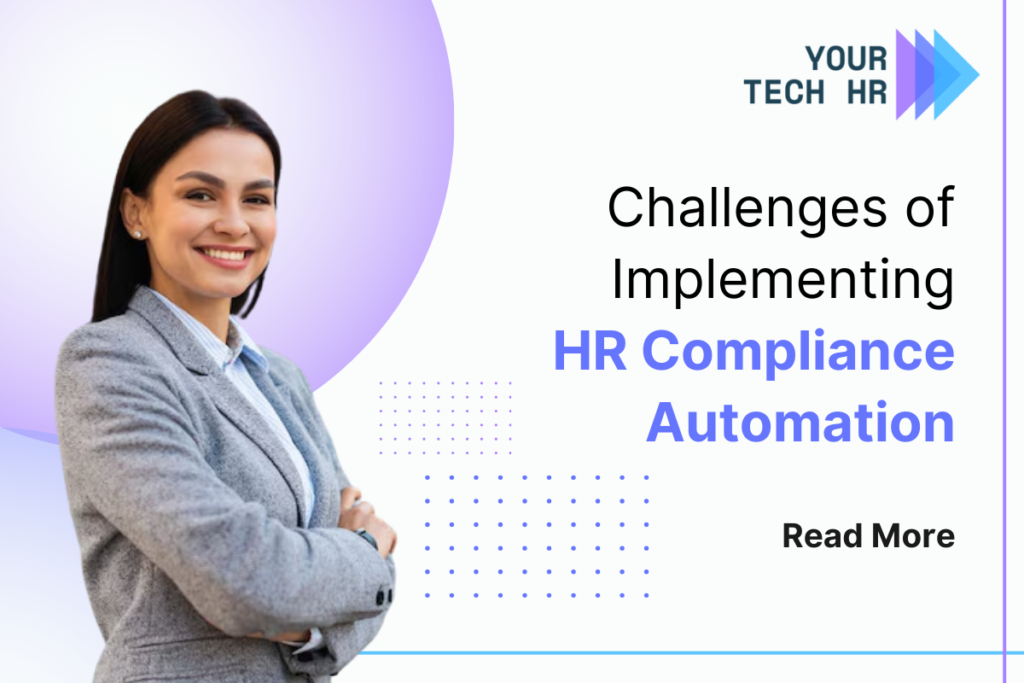As organizations strive to enhance their human resources (HR) practices, HR compliance automation has emerged as a critical solution for managing regulatory requirements and streamlining processes. However, the journey toward successful implementation is fraught with challenges. This blog will explore the challenges of implementing HR compliance, focusing on issues such as regulatory compliance, data privacy, employee training, and technology integration.
Understanding HR Compliance Automation
HR compliance automation refers to the use of technology to streamline and automate various HR processes related to compliance. This includes automating tasks such as policy management, employee tracking, training, and reporting. By leveraging automation tools, organizations can ensure that they remain compliant with relevant regulations while minimizing the administrative burden on HR teams.
The Importance of HR Compliance
Maintaining compliance in HR is crucial for several reasons:
- Legal Protection: Adhering to compliance regulations protects organizations from legal repercussions and potential lawsuits.
- Employee Trust: Maintaining compliance fosters a sense of trust among employees, knowing that their rights are protected.
- Operational Efficiency: Effective compliance processes contribute to overall operational efficiency by reducing the risk of errors and misunderstandings.
- Reputation Management: Organizations that prioritize compliance are viewed more favorably by customers and stakeholders.
Key Challenges in Implementing HR Compliance Automation
While the benefits of HR compliance automation are significant, organizations may encounter several challenges during implementation:
1. Regulatory Compliance
One of the primary challenges organizations face when implementing HR compliance automation is navigating complex regulatory requirements.
- Understanding Regulations: Organizations must have a thorough understanding of applicable regulations that govern HR practices, including labor laws, workplace safety regulations, and data protection laws.
- Adapting to Changes: Regulatory requirements can change frequently, making it essential for organizations to stay updated on new laws and adjust their compliance practices accordingly.
2. Data Privacy Concerns
As organizations collect vast amounts of sensitive employee data, ensuring data privacy is paramount when implementing automation solutions.
- Compliance with Data Protection Laws: Organizations must navigate regulations such as GDPR (General Data Protection Regulation) and CCPA (California Consumer Privacy Act), which dictate how personal data can be collected, stored, and used.
- Building Trust: Employees are increasingly concerned about how their data is used. Organizations must prioritize transparency regarding their data practices to build trust with employees.
3. Employee Training
Effective employee training is critical for ensuring that staff members understand new compliance processes and technologies.
- Resistance to Change: Employees may resist adopting new technologies or processes due to fear of job displacement or unfamiliarity with the tools.
- Ongoing Education Needs: As regulations evolve, continuous training is necessary to ensure employees remain compliant with current laws and best practices.
4. Technology Integration
Integrating new HR compliance automation tools with existing systems can be complex and resource-intensive.
- Compatibility Issues: Many organizations rely on legacy systems that may not easily integrate with modern HR automation solutions. This can lead to inefficiencies if not addressed properly.
- Implementation Costs: The costs associated with integrating new technologies can be significant; organizations must consider both time and resources required for successful integration.
5. Data Management Compliance
Managing data effectively is crucial for maintaining compliance within HR departments.
- Data Quality Issues: Inaccurate or incomplete data can lead to poor decision-making and ineffective compliance processes.
- Data Silos: Different departments may store data in separate systems, making it difficult to access comprehensive insights related to compliance efforts.
Conclusion
In conclusion, understanding the challenges of implementing HR compliance automation is essential for organizations seeking innovative ways to enhance service delivery while navigating an increasingly competitive landscape. By leveraging effective strategies alongside advanced technologies—such as predictive analytics, data compliance initiatives, and sustainable practices—businesses can position themselves at the forefront of industry advancements!


